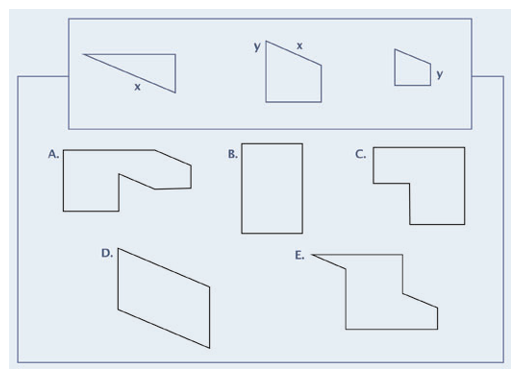The ISEB Test (Independent Schools Examination Board) is a set of standardized tests used by many independent schools in the United Kingdom to assess students for admission. Taken in the 6th and 7th grades, it is designed to assess the academic abilities and potential of students seeking admission to a variety of senior independent schools in the UK and abroad.
This page includes free practice questions, with detailed explanations and valuable tips for the different sections of the ISEB test. Register for the ISEB, and then continue below to read additional information and practice ahead of your child's upcoming ISEB test.
Free ISEB Practice Test Questions
The ISEB test, also known as ISEB Common Pre-Test, is computerized and can be taken in your child's prep school or one of the senior schools you're applying for. The test is also adaptive, meaning that the difficulty increases the more your child succeeds.
The ISEB test includes four subjects, all of which adds up to about 2 hours and 15 minutes. The subjects are:
- English - This section assesses reading comprehension, writing skills, and knowledge of grammar and vocabulary. The section has a time limit of 40 minutes.
- Mathematics - This section tests numerical skills, problem-solving abilities, and understanding of mathematical concepts. The section has a time limit of 40 minutes.
- Verbal Reasoning – This section measures the use of language while demonstrating logical and critical thinking skills. The section has a time limit of 25 minutes.
- Non-Verbal Reasoning – This section includes abstract reasoning and assesses your child's spatial abilities to solve 2D and 3D questions. The section has a time limit of 30 minutes.
Let's begin with the English section.
Interested in homeschooling your child? Learn everything you need to know about homeschooling.
Free ISEB Test English Practice Questions
The questions in the section are either reading comprehension (answering according to a short text) or grammar.
Text: The French Love Affair with Cuisine
1 French people are renowned for their love of food, and it often takes center stage in their daily conversations. A recent survey found that 85% of French adults talk about food at least once a day, with some discussing it even more frequently. On average, a French person spends around three months of their life talking about culinary delights. Moreover, food-related posts on social media are quite common, with individuals sharing recipes, restaurant reviews, and photos of their meals several times a week.
2 The famous writer and philosopher Voltaire once remarked on this culinary passion, noting that for the French, a meal is more than just sustenance; it is a celebration of life. This perspective highlights the cultural importance of food in France, where meals are often leisurely affairs, marked by multiple courses and accompanied by lively discussion. Unlike in many other cultures, where eating can be rushed or solitary, the French tradition emphasizes the social and communal aspects of dining.
3 The roots of this gastronomic obsession can be traced back to historical and geographical factors. France's diverse climate and fertile soil allow for a wide variety of fresh produce, making seasonal eating a natural choice. Furthermore, the country's rich culinary history, influenced by royal courts and regional traditions, has led to the development of a sophisticated and varied cuisine. From the buttery croissants of Parisian cafes to the rich cassoulets of the southwest, French food is celebrated for its quality and diversity.
Q1: Look at paragraph 1.
How long does the average French person spend talking about culinary delights?
Q2: The sentence below is from paragraph 3.
France's diverse climate and fertile soil allow for a wide variety of fresh produce, making seasonal eating a natural choice.
Which word is closest in meaning to fertile?
ISEB English Tip – Start from the Questions:
One of the most useful tips for reading comprehension – the text can consume valuable time if it is read first since you will have to return to it after reading the question. We recommend starting from reading question, which in many instances directs where the answer is supposed to be found, thus saving valuable time and being focused on the relevant information for each question.
Help Your Child Prepare for Their ISEB Test
Explore our ISEB Practice PrepPack that includes
Realistic Simulations
PrepPacks tailored to accurate test scenarios.
Interactive Tests
Practice materials, designed to help students perform their best on their tests!
Premium Quality
Expert-crafted practice tests with accurate questions and explanations
Q3: Choose the word that best completes the sentence below.
Make sure ________ seatbelt is fastened before takeoff.
Q4: Select the word that does not fit in the sentence once it is rearranged.
time delicious bakes she cookies every friend
The ISEB Test English section is challenging, requiring you to demonstrate reading, understanding, and interpretation skills, while also testing your overall grammar knowledge. However, with adequate preparation and the usage of solving techniques, your child can unlock their full potential.
Let's look at the mathematics section next.
Free ISEB Test Mathematics Practice Questions
There are a few different topics in this section, including calculations, fractions, decimals, percentages, geometry, and statistics.
Q5: Which of the following numbers is a multiple of 14?
Q6: Which fraction is between 0.12 and 0.19?
ISEB Mathematics Tip – Eliminate Smartly:
In multiple-choice questions, especially in calculations, you can quickly eliminate options by comparing the distractors. For example, in the last question, you can start by examining 1/5, and when you realize it is above the given range, eliminate every higher option (i.e., 1/4). That way you can work with easier calculations, and with less – thus saving valuable time.
Q7: Sarah reads a book for 45 minutes every evening.
If she reads 90 pages in that time, what is her average reading speed?
Q8: A round cake is cut into 6 identical slices. What angle do 2 slices account for?
ISEB Test Results:
The ISEB Test is unique, in terms that the test does not have a specific score or results. Once your child completes the test, the results are sent to the senior schools you applied for, and you can contact them. Each school can revise your child's attempt differently, focusing on specific traits.
However, there are a few notes you should remember, which will affect your child's success in the test:
- The test is interactive – therefore, the more consecutive questions your child will answer correctly, the harder the questions will become. Achieving more advanced questions and answering them correctly will most likely put your child in a better place than answering more questions but making many mistakes.
- Your child's success is compared to others – the test is given in different formats and has different questions according to dates and success. Therefore – the test is normalized, and your child should aspire to succeed more than other children of the same age.
- Talk with the senior school – since each senior schools receives your child's accomplishment independently to other schools, contact the school to get a better understanding of what should your child focus on ahead of the test.
Free ISEB Test Verbal Reasoning Practice Questions
There are a few different topics in this section, including comprehension, reasoning, and logic, and will have a big portion of synonyms, antonyms, and analogies.
Q9: Which one letter completes all the words below?
__all __at __ook __ite
Q10: Select the pair of words that are closest in meaning to each other.
Q11: The first pair of words is related in some way.
Complete the second pair of words in the same way.
book : chapter tree : _________
ISEB Verbal Tip: Create Sentences
In the last two questions, you were given pairs of words, and to answer you had to create a connection between the pairs. To best approach such questions (analogies, synonyms, antonyms, etc.,) your child must be able to create a sentence that connects the words (i.e., a book is made of many chapters, or furious is being very angry about something). Work with your child by reading books and paragraphs and try to interpret words they are unfamiliar with by context.
Q12: Select the word that is most nearly opposite in meaning to the word in bold.
Abundant
While it seems that the English and Verbal Reasoning sections are similar – when diving in it is evident that they are very different. In the English section, your child's understanding of the written text and proper use of English words were measured, while in the Verbal section, the questions refer to the meaning of words, logically connecting words and comparison.
Let's look at the final section of the ISEB test, the Non-Verbal Reasoning section.
Free ISEB Test Non-Verbal Reasoning Practice Questions
This section focuses on different cognitive skills, such as understanding similarities and differences, analyzing codes, and spatial reasoning in 2D and 3D.
Q13: Below are five figures, four of which have a code of letters.
Choose the correct letters to complete the code to the figure on the right.

ISEB Non-Verbal Tip – Look for Common Patterns:
Most of the questions in the Non-Verbal section of the ISEB test include figures, which are connected by specific patterns, either in a matrix form, next in series, etc. In most cases, a few common rules apply in said patterns – i.e., switching geometrical shapes (with specific positions), addition/subtraction of the number of sides/figures, and clockwise/counterclockwise movement (like in the previous example). Practice many spatial questions and learn how to intuitively look for those common patterns, to be able to quickly solve most questions with ease.
Q16: The letters near the sides of each shape point out where exactly should the different shapes be joined together.
Which of the following options shows the joint shape?

ISEB Reading Tip – Start with the Questions:
With a minute for each question – and that includes reading the text as well, this section may be the most time-pressured. Therefore, we recommend starting each text by reading the question first, and only then returning to the text and looking for answers, including using keywords (i.e., on question #5, look for a challenge). That way you can save yourself unnecessary reading of the text.



